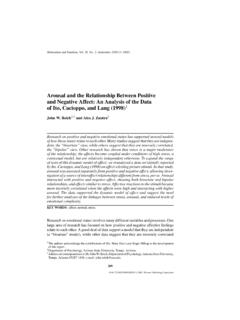Transcription of The Relationship between Attention and Working Memory
1 In: New Research on Short-Term Memory ISBN 978-1-60456-548-5 Editor: Noah B. Johansen, pp. 2008 Nova Science Publishers, Inc. Chapter 1 The Relationship between Attention and Working Memory Daryl Fougnie Vanderbilt University Abstract The ability to selectively process information ( Attention ) and to retain information in an accessible state ( Working Memory ) are critical aspects of our cognitive capacities. While there has been much work devoted to understanding Attention and Working Memory , the nature of the Relationship between these constructs is not well understood.
2 Indeed, while neither Attention nor Working Memory represent a uniform set of processes, theories of their Relationship tend to focus on only some aspects. This review of the literature examines the role of perceptual and central Attention in the encoding, maintenance, and manipulation of information in Working Memory . While Attention and Working Memory were found to interact closely during encoding and manipulation, the evidence suggests a limited role of Attention in the maintenance of information. Additionally, only central Attention was found to be necessary for manipulating information in Working Memory .
3 This suggests that theories should consider the multifaceted nature of Attention and Working Memory . The review concludes with a model describing how Attention and Working Memory interact. I. Introduction The capacity to perform some complex tasks depends critically on the ability to retain task-relevant information in an accessible state over time ( Working Memory ) and to selectively process information in the environment ( Attention ). As one example, consider driving a car in an unfamiliar city. In order to get to your destination, directions have to be retained and kept in Working Memory .
4 In addition, one must be able to selectively attend to the relevant objects because there is more information in a scene than can be processed by our Daryl Fougnie 2 perceptual systems. In fact, the contents of Working Memory and Attention often overlap. If the directions stored in WM instruct you to turn left after the yellow water tower, then Attention may be guided towards objects that resemble a yellow water tower. Although the contents of WM and Attention are often the same, the exact Relationship between these two constructs is not fully understood.
5 Empirical work has largely focused on separate aspects of their Relationship , asking questions such as: 1) is attending to something necessary to encode it into WM? 2) do the contents of WM automatically guide Attention ? 3) can an Attention demanding task and a WM task be performed in parallel? 4) does our capacity for WM predict performance on Attention tasks? By themselves, these questions can provide insight into our complex cognitive machinery, however, unless effort is expended to integrate the answers into a coherent framework, a general understanding of the connection between Attention and WM will remain elusive.
6 Theoretical models of WM often describe a role for Attention . However, across these models there is not much agreement on the role of Attention . Some theorists argue that Attention selects the information to be encoded into WM while others speak of Attention in terms of post-perceptual processing limitations (Kintsch, Healy, Hegarty, Pennington, and Salthouse 1999; Miyake and Shah, 1999). While theoretical work on the Relationship between Attention and WM has generally assumed that both constructs denote a uniform set of processes, there is strong evidence implicating non-unitary Attention and WM systems (Posner and Peterson, 1990; Smith and Jonides, 1999).
7 Miyake and Shah (1999) have suggested that an understanding of the role of Attention in WM might require a systematic mapping of the relationships between different aspects of WM and those of Attention . Indeed, Awh and colleagues have suggested that the interaction of Attention and WM depends on what stage of Attention is engaged and what type of information is being maintained in WM (Awh, Vogel, and Oh, 2006). In this review of the existing literature, I will attempt a thorough review of the Relationship amongst distinct processing stages in WM and distinct forms of Attention .
8 I begin by describing how the terms Attention and WM are defined here. Attention refers to the processing or selection of some information at the expense of other information (Pashler, 1998). It has been debated at which processing stage attentional selection occurs. There is evidence that Attention can affect early perceptual processing (Cherry, 1953; Mangun and Hillyard, 1991) as well as evidence that Attention affects only later processing stages (Osman and Moore, 1993). The strong support for both early and late selection has led to the proposal that there may be more than one form of attentional selection (Allport, 1993; Lavie, Hirst, de Fockert, and Viding, 2004, Luck and Vecera, 2002; Posner and Peterson, 1990).
9 One detailed and influential taxonomy of Attention has been developed by Posner and colleagues (Fan, McCandliss, Sommer, Raz, and Posner, 2002; Fan, McCandliss, Fossella, Flombaum, and Posner, 2005; Posner and Boies, 1971; Posner and Peterson, 1990). According to recent conceptions of this taxonomy, there are three Attention networks that perform distinct roles: alerting, orienting, and executive Attention . The alerting network controls the general state of responsiveness to sensory stimulation. The orienting network selects a subset of sensory information for privileged processing.
10 Several mechanisms have been proposed to account for the beneficial effects of attentional orienting including neural boosting (Luck, Hillyard, Mouloua, and Hawkins, 1996; Mangun and Hillyard, 1991), distractor suppression (Reynolds, Pasternak, and Desimone, 2000; Slotnick, The Relationship between Attention and Working Memory 3 Schwarzbach, and Yantis, 2003), and noise reduction (Dosher and Lu, 2000). The executive Attention network acts on post-sensory representations, and is needed when there is competition for access to a central, limited-capacity system.


